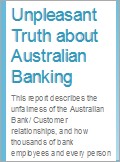It is virtually impossible to function in the 21st century without having a relationship with a bank, as the cash economy has been replaced with an efficient payments system.
However, less regulation in the banking and financial industry over the past forty years has resulted in banks accumulating monopoly powers. This was evident in 1991 and caused the government to commission a committee headed by Stephen Martin to investigate emerging issues. It recommended documenting of the Code of Banking Practice to set fair banking principles, representing a consensus of views in the banking and finance industry.
In order to balance the bank/ customer relationship, legislators and regulators, banks and customer advocates needed to implement fair and enforceable principles, enabling the banks and customers to trust each other. This paper reviews the effectiveness of self-regulation and its shortcomings, and problems that need to be dealt with.
This paper follows the history of events and reports, many with recommendations that have been overlooked. The reports include:
1981 Campbell Report
1991 Martin Report
1996 Australian Bankers Code
1997 Wallis Report
2001 Richard Viney Report
2003 Banking Code
2004 Banking Code
2005 ANU FEMAG Report
2008 McClelland Report
2008 Richard Viney Review
This paper examines the banks motives and the extent to which bank directors failed to respect the public’s need to implement fair and prudent practices, in the interest of all parties. These standards were painstakingly researched and documented in 1991 by the Martin Committee.
Banking And Integrity
In 1981 the Campbell Committee handed down its report noting potential shortcomings which have since been overlooked by politicians in an effort to encourage competition in the banking and financial sector. Banker’s integrity suffered.
However, bank directors and managers held on to the controls, becoming addicted to increasing profits and powers, which provided increasing financial rewards to bank shareholders and senior management based on rising profits. This was at the expense of banking efficacy and customer safeguards.
The research for this paper followed two pathways:
Part 1: Steps taken by legislators to allow banking to be more flexible, based on the government’s belief deregulation was necessary to encourage competition, and
Part 2: How banks wrestled consumer protection away from the legislators and regulators, claiming to introduce and enforce their own higher-standards.
Prior to 1991 banks relied on the courts and expensive lawyers to maintain their considerable advantage of being able to use vast resources to silence their critics. They also relied on the ABA’s public relations machine to make statements furthering the interests of the code subscribing banks.
Banks commitment to customer protection became secondary as banks encouraged legislators and regulators to turn a blind-eye while they increased powers and profits. The banks marginalised the self-regulated Code with Code Compliance Monitors sidestepping commitments to investigate complaints and make a determination on any allegation by any person a subscribing bank breached the Code.
In 2003 the Code of Banking Practice was revised with banks incorporating their preference to restrict the independence and authority of the newly appointed Code Compliance Monitors. Banks restricted the Code Compliance Monitors from naming them when they breached the Code (unless they were repeat offenders), and only then in the Compliance Monitors Annual Report.
Efficacy and Code (2004)
In 2004 the ABA published the modified Code and sixteen banks adopted it. At the time, 102 bank directors knew the bank CEOs constitution had already been preparred to limited the independence and authority of the Code Compliance Monitors.
The constitution, prepared in 2004, ‘identified how banks could control the way the Code Compliance Monitors carried out their role’. With it, the Martin Committee’s ambition that ‘no-one-is-taken-for-a-ride’ would not be realised.
The 2004 constitution signalled a green light for banks to adopt the Code; ignoring promises they would comply with the Code (see bank promises in chapter 20). The banks simply promoted the Code without commenting on the constitution and used it as a cunning strategy to win customers trust.
This paper identifies problems that must have been experienced by many thousands of customers and small businesses that relied on the bank/ customer contract believing the key principles in the Code of Banking Practice were enforceable.
Senate Committee Report webpage (Sub No. 90): click here…
